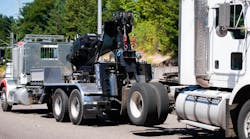Continuous quality improvement is an accepted part of modern manufacturing, but the concept of always striving to do better, always raising the bar on expectations should also be considered a fundamental element of truck safety.
Preliminary statistics just released by the National Highway Traffic Safety Administration (NHTSA) show the industry continues to move in the right direction on safety. According to the most recent NHTSA report, in 2004 the number of trucks involved in fatal accidents dropped to 1.96 per 100 million truck miles traveled, compared to 2.19 the year before.
To understand just what a leap in safety this number represents, let's look at it from another angle. The total number of trucks in fatal accidents actually rose in 2004 to 4,862, from 4,721 the year before, or 3%. But total miles traveled by large trucks jumped 15% over the same period, to 248 billion from 216 billion miles. The increase in miles run by large trucks was five times greater than their increase in fatal accident involvement.
While it might seem like ancient history in this age of rapid change, think back to 2004 and the conditions faced by trucking. After two years of recession, the economy kicked back into gear, and there was finally plenty of freight for those who had survived. That meant for-hire fleets had to bring in large numbers of new drivers to handle the increase, and they were putting them into a truck fleet with the oldest average life we'd seen in a long time. Sounds like a recipe for a safety disaster.
Instead, it seems that trucking pushed ahead in efforts to improve safety. Expanding business, less experienced drivers and older equipment weren't enough to derail the quest for continuous improvement.
Over the next few months, you're going to hear a lot of discussion about why the fatal accident involvement number dropped so much. Certainly higher seatbelt use by drivers of all vehicles contributed, as did improvements in car safety technology. And many will argue that the new hours-of-service rules that took effect in 2004 also played a role, if only because they reduced waiting-time abuse by shippers.
As informed and well-intentioned as those arguments may be, we shouldn't let them distract us from the real issue — finding the next gain in truck safety.
After years of delay, NHTSA has finally released its new truck-brake rules, calling for a 20% to 30% decrease in heavy-truck stopping distance. Although it will take awhile for these new brake designs to become a significant factor on the roads, that should be part of the solution as we look for improvement.
Rules requiring electronic onboard recorders for driver logs could also be an important step. A proposal is expected shortly, and it will certainly be unpopular with some. However, the American Trucking Assns. has already indicated that it will drop its opposition, and support for what I believe is inevitable is growing among the more responsible fleets. If you don't believe me, just look at the growing number voluntarily adopting automated log systems.
Those of you responsible for the trucking industry's latest gains in safety deserve high praise for a job well done under difficult circumstances. Just remember that better is never the best you can do.
E-mail: [email protected]
Web site: fleetowner.com


